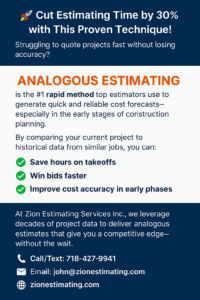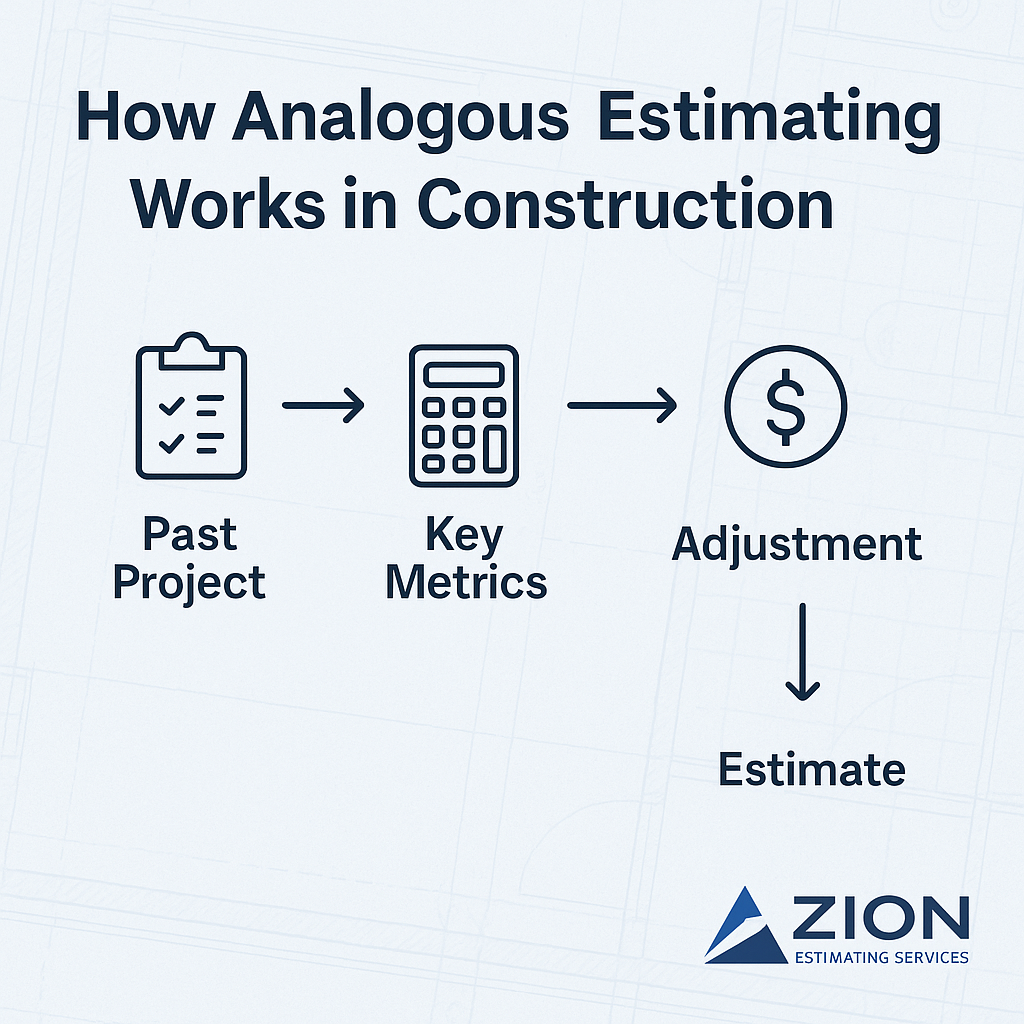Learn how analogous estimating helps construction professionals quickly forecast project costs using past data. Discover benefits, examples, and how Zion Estimating Services Inc. can help.
Unlock Project Success with 1 Powerful Technique: Analogous Estimating Explained
When speed and simplicity are essential in the early stages of a construction project, analogous estimating can be a game-changer.
At Zion Estimating Services Inc., we understand that not every project begins with a full set of detailed plans. That’s where this powerful, experience-based technique shines — giving you fast, informed estimates using historical data.
In this post, we’ll walk you through everything you need to know about analogous estimating, when to use it, its pros and cons, and how it fits into a modern cost estimating strategy.
What is Analogous Estimating?
Analogous estimating, also called top-down estimating, is a technique that uses historical data from similar past projects to estimate the cost or duration of a current project.
Instead of calculating every material and labor component, you base your estimate on a comparable project that’s already been completed. Then, you adjust the cost for differences in scale, complexity, location, or timeline.
Example: If you previously built a 10,000 sq. ft. commercial building for $2 million, you might estimate a similar new build at $2.1 million after factoring in inflation and design upgrades.
Why is Analogous Estimating So Popular in Construction?
-
Speed: Quick cost estimates for budgeting or feasibility studies
-
Simplicity: No need for detailed architectural or engineering plans
-
Benchmarking: Helps validate or sanity-check bottom-up estimates
-
Decision Support: Great for early project go/no-go decisions
When to Use Analogous Estimating
This method is ideal for:
-
Feasibility studies and pre-design phases
-
Conceptual estimating for developers or investors
-
Early-stage planning when limited scope details are available
-
Government projects using historical bid data
At Zion Estimating, we often use analogous methods during preconstruction budgeting, especially when clients are still developing their design and need ballpark figures to secure financing or stakeholder approval.
Step-by-Step Process for Analogous Estimating
Here’s how the technique works:
1. Identify a Similar Past Project
Find a completed project that closely resembles the one you’re estimating — in type, scale, and location.
2. Collect Historical Data
Pull final cost reports, square footage, labor hours, and timeline info.
3. Adjust for Variables
Factor in inflation, changes in materials, updated codes, or client preferences.
4. Document Assumptions
Record what data you used and what changes you made. This ensures transparency and trust.
5. Deliver the Estimate
Present the adjusted estimate with supporting logic and contingencies.
Real-World Example: Office Fit-Out Project
Let’s say Zion Estimating completed an office fit-out in New Jersey in 2022 for $95 per square foot.
A new client wants to fit out a similar space in Queens, NY, in 2025.
Here’s how analogous estimating might work:
| Factor | 2022 Project | 2025 Estimate |
|---|---|---|
| Square footage | 5,000 sq. ft. | 6,000 sq. ft. |
| Location cost variance | NJ baseline | +5% (NYC premium) |
| Inflation | 0% | +8% (over 3 years) |
| Complexity | Standard | Slightly complex (+3%) |
Final estimate:
$95 x 1.05 x 1.08 x 1.03 ≈ $110.60 per sq. ft.
Total: $110.60 × 6,000 = $663,600
That’s how fast and effective analogous estimating can be.
Advantages of Analogous Estimating
✅ Fast Turnaround – No need for detailed takeoffs
✅ Low Cost – Less labor-intensive than parametric or bottom-up methods
✅ Strategic Insights – Identifies trends in project performance
✅ Good for Stakeholder Buy-In – Gives non-technical clients an early cost ballpark
Disadvantages to Watch Out For
⚠️ Accuracy Depends on Data Quality – Poor data = bad estimates
⚠️ Subjective Adjustments – Bias can creep into scope comparisons
⚠️ Limited Detail – Can’t replace detailed cost breakdowns for execution
⚠️ Not Ideal for New or Unique Projects – You need a close match
At Zion Estimating Services Inc., we always pair analogous estimating with expert judgment and, when needed, shift to parametric or detailed estimating methods in later project phases.
Tips to Improve Analogous Estimating Accuracy
🔹 Use normalized historical data adjusted for time and geography
🔹 Compare multiple past projects, not just one
🔹 Include contingencies for unknown scope details
🔹 Document all assumptions to avoid confusion later
🔹 Collaborate with experienced estimators like our team at Zion Estimating
How Analogous Estimating Compares to Other Methods
| Method | Data Type | Speed | Accuracy | Best For |
|---|---|---|---|---|
| Analogous | Historical | High | Medium | Early planning |
| Parametric | Statistical models | Medium | High | Repetitive elements |
| Bottom-Up | Detailed takeoffs | Low | Very High | Execution phase |

Why Work With Zion Estimating Services Inc.?
With years of experience in cost estimating across commercial, residential, and infrastructure sectors, Zion Estimating Services Inc. brings:
-
A rich database of completed project costs
-
Proven processes for data-driven estimating
-
Deep knowledge of regional construction economics
-
Flexible delivery: Excel reports, presentations, or construction software formats
-
Fast response times – call/text us anytime at 718-427-9941
Final Thoughts: Is Analogous Estimating Right for You?
If you’re looking for a quick, early-stage estimate for a construction project — especially when full details aren’t available yet — analogous estimating is a powerful, professional solution.
When combined with expert judgment and historical insights, it becomes an essential part of any smart cost estimation strategy.
Let Zion Estimating Services Inc. help you turn your project vision into financial clarity.
📞 Contact Zion Estimating Today
✅ Call or Text: 718-427-9941
✅ Email: [email protected]
✅ Website: zionestimating.com
